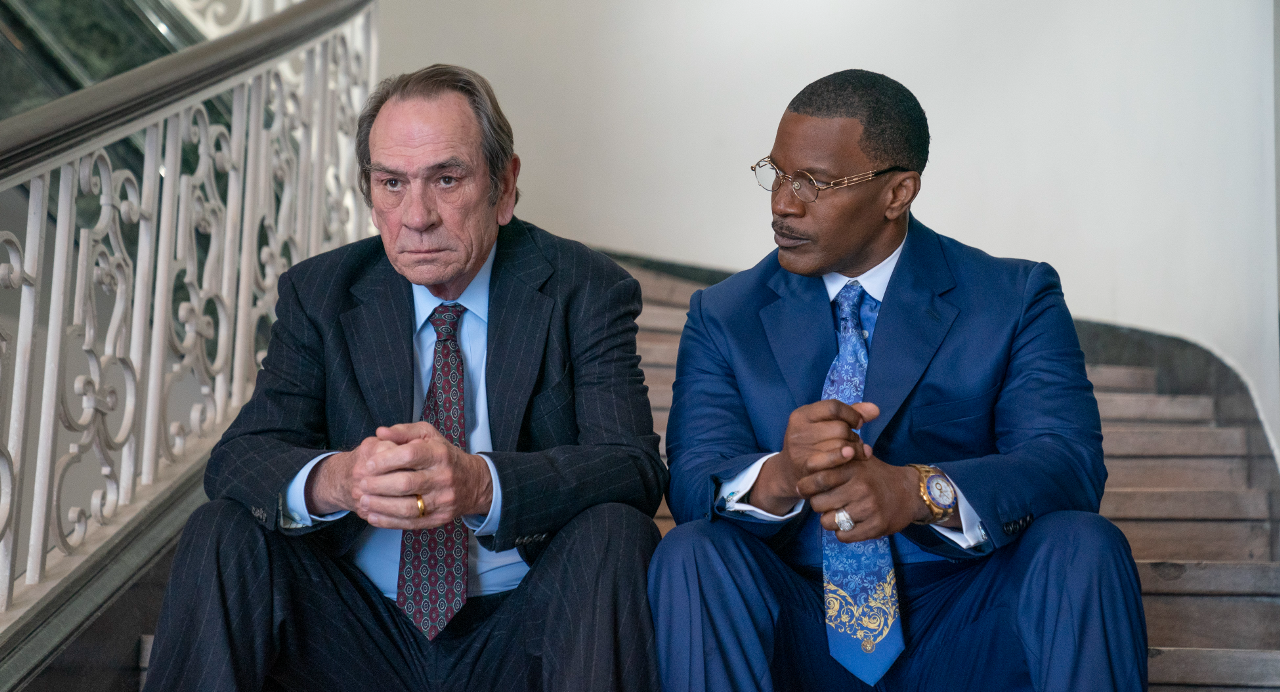 Streaming pioneers Amazon Prime and Netflix have begun to roll out their fall releases.
Streaming pioneers Amazon Prime and Netflix have begun to roll out their fall releases.
Now streaming on Amazon Prime is The Burial starring Oscar winners Jamie Foxx and Tommy Lee Jones.
Set in the mid-1990s, this comedy-drama is based on the true story of a funeral director’s suit against a conglomerate for breach of contract and is not a great film, but it is a pleasant time killer cozily directed by Maggie Betts.
Tommy Lee Jones plays a 75-year-old funeral director who needs money to keep his family business secure for his heirs. In order to do so, he enters into a deal with a fast-talking Canadian businessman played by Bill Camp who agrees to purchase three of Jones’ funeral parlors in exchange for not selling burial insurance in Jones’ part of Mississippi. They shake hands to seal the deal which Jones immediately signs, turning the three funeral parlors over to Camp. Camp holds off signing while he continues to sell burial insurance where he has agreed not to.
Jones hires a famous Florida based personal injury lawyer played by Jamie Foxx to sue Camp for breach of contract. At issue is whether there was a contract since it was not signed by both parties. What starts out as a $6 million suit escalates into a $500 million one.
Both Foxx and Jones deliver strong performances, Jones having taken over from a role intended for his The Fugitive co-star Harrison Ford.
In addition to Camp, there are good supporting performances by Jurnee Smollet as Camp’s Harvard trained lawyer, Alan Ruck and Mamoudou Athie as Jones’ original lawyers, who become Foxx’s co-counsel, Amanda Warren as Foxx’s wife, and Pamela Reed as Jones’ wife.
Now streaming on Netflix is Fair Play. Coincidentally, this was also directed by a woman, but there is nothing cozy about Chloe Domont’s direction.
Set in the cutthroat world of Wall Street hedge funds, the setting could have been in any business where a couple in a romantic relationship is torn apart when one is given a promotion that was expected to go to the other one.
Chloe Dynevor, an actress whose work I’m not familiar with, and Alden Ehrenreich (Hail, Caesar!) are the couple secretly living together who then become secretly engaged before a key position opens up at the office where they both work.
Ehrenreich is rumored to be the one to get the job, but Dynevor is unexpectedly promoted instead. He is at first happy for her, expecting that his turn will come soon, but as time goes on that doesn’t seem to be in the cards. Love turns to hate and betrayal by both against the other in what is a rather unseemly screenplay in which one gets what they wanted and the other is left disillusioned.
Eddie Marsan leads the supporting cast.
On the media front, Universal has released newly improved 4K UHD editions of two of its horror classics, 1935’s The Bride of Frankenstein and 1943’s The Phantom of the Opera, its first in color.
If 1968’s Rosemary’s Baby and 1973’s The Exorcist represent the best in modern horror films, and they do, The Bride of Frankenstein represents the best of the genre in the early talkies.
While James Whale is best remembered as a great horror film director, it should be noted that he only directed four, 1931’s Frankenstein, 1932’s The Old Dark House, 1933’s The Invisible Man, and this film.
Whale was brought to Hollywood to direct the 1930 war film, Journey’s End, which he had directed on Broadway the year before. His next film was the first screen version of Waterloo Bridge, starring Mae Clarke. Frankenstein was his third film. The Old Dark House his fifth and The Invisible Man his seventh. The Bride of Frankenstein was his tenth. His non-horror films include 1933’s The Kiss Before the Mirror, 1936’s definitive version of Show Boat, and 1939’s highly regarded film of The Man in the Iron Mask.
Whale had resisted doing a sequel to Frankenstein for four years but finally relented when given artistic freedom in the absence of studio head Carl Laemmle. Boros Karloff objected to his character having to speak but was overruled. His monster makeup took four-to-five hours daily to apply. Elsa Lanchester as the monster’s bride took three, which is why the two are seldom seen in the same shot.
Although Colin Clive reprised his role as the monster’s creator from the original, Valerie Hobson replaced Mae Clarke as his wife due to Clarke’s illness at the time. In addition to Lanchester, who plays both author Mary Shelley and the monster’s bride, Una O’Connor has a dual role. She is seen as Mary Shelley’s maid in the prologue and as the screaming woman at the end of the film.
Sadly, it received just one Oscar nomination for its sound.
The Phantom the Opera fared better at the Oscars having been nominated for four including Best Cinematography – Color, Best Art Direction, Set Decoration – Color, Best Sound Recording, and Best Score. It won for the first two.
Universal had been attempting to remake Lon Chaney’s 1925 classic since 1935 but plans kept falling apart. The last attempt had been in 1941 when they wanted Charles Laughton to play the phantom and Deanna Durbin the damsel in distress.
Claude Rains, who had the title role in Whale’s The Invisible Man, had the title role with Nelson Eddy and Susanna Foster as the romantic leads when the film was finally remade as a musical. It was directed by Arthur Lubin.
Happy viewing.



















Leave a Reply
You must be logged in to post a comment.